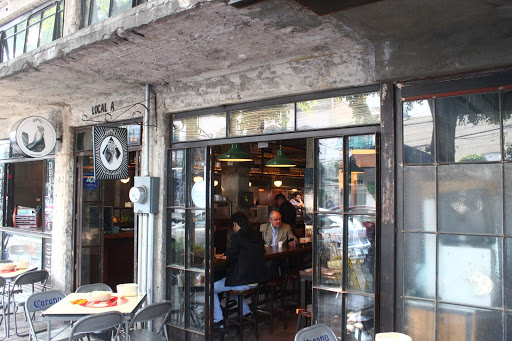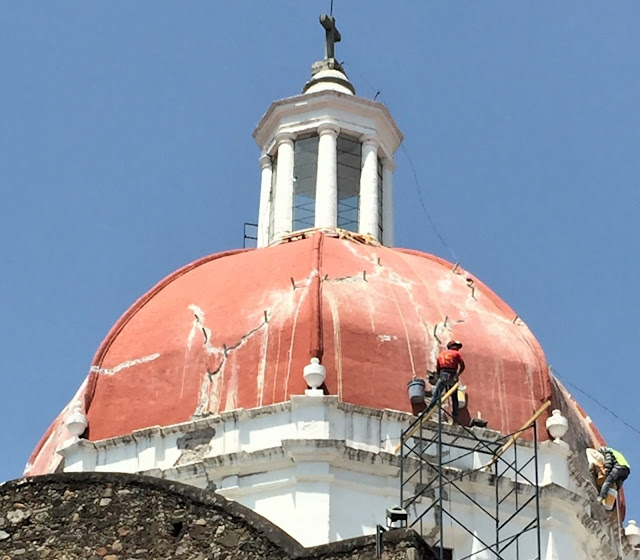March 13, 2018
From there, the drive to Cuernavaca takes about an hour and a half.
As we were getting on (or maybe off) the freeway, we noticed this horseman amidst the various overpasses--a rather unusual placement for the statue, don't you think?
Cuernavaca is the capital of the state of Morelos and its largest city. The famous 19th-century Prussian naturalist Alexander von Humboldt nicknamed Cuernavaca "The City of Eternal Spring" because of its near perfect climate and rich vegetation. However, the day we were there it was unseasonably, miserably hot.
This fascinating painting of the Trinity hangs on the wall in the chapel. Most paintings of the Trinity I have seen depict three very different personages. God the Father is usually white-haired and bearded, Jesus Christ is young, and the Holy Ghost is most often depicted as a dove. In this painting the three faces are identical, but the figure on the left (Christ) has the mark of the crucifixion on his palm and foot and a lamb on his chest; the center figure (God the Father) has the sun on his chest; and the figure on the right (the Holy Spirit) is holding a dove. Together, the three figures grasp what looks like a scepter of some kind.
Hmmm...I'm pretty sure this is NOT Don Borda. Who is he? Pancho, is that you again?
Definitely a "Lifestyles of the Rich and Famous" kind of a place.
I don't remember where I saw the sign below, but I was impressed by the motto: "The earth will return to those who work it with their hands." This is a famous quote from Emiliano Zapata (1879-1919), a legendary Mexican revolutionary who fought against the dictatorship of Porfior Diaz and called for land reform that would include redistributing land to the peasants. The words in the white U at the top of the corn plant are "Land and Liberty." We later saw the same crest on a building--maybe a government building?
Arnold picked us up at 9:00 AM for a trip to Cuernavaca and Taxco. However, first we had to eat some breakfast, so Arnold chose a fun restaurant, Lonchería Bravo Torta de Suaderó.
I tried something new: a cazuela, or a Mexican version of a breakfast casserole with eggs, meat, sauce, and other ingredients.
Could it be Pancho Villa?
We were visiting both Cuernavaca and Taxco on the same day, so we really didn't have time to see much. (This is definitely one of several places we should return to on a future visit to Mexico.) Our goal was to see the Cathedral of the Assumption of Mary, aka Cuernavaca Cathedral, one of the fourteen 16th-century monasteries built on the slopes of Popocatepetl Volcano. As a group, the fourteen monasteries are a UNESCO World Heritage Site.
The Cuernavaca Cathedral is not just one building, but a monastic complex that includes the main cathedral and at least two additional two chapels, all surrounded by a wall. It reminded me a little bit of the LDS Temple Square in Salt Lake City. The monastery was originally built in the early 16th century for the evangelization of the indigenous people, but later became the the parish church for Cuernavaca. In the late 19th century the main church was elevated to the rank of cathedral.
We made our way to the rather gloomy entrance to the cathedral, built by Cortes to double as a fortress.
The stone angels flanking a niche above the door look 500 years old . . .
. . . as does the macabre cross balanced on top of a skull and crossbones. Not a super inviting entrance, is it? The Franciscan emblem today is a cross atop two crossed (and fully-fleshed) arms--no skull. I'd say that is a big improvement over this.
Like the other 16th century churches we had visited, this one was also closed because of the 7.1 earthquake that had occurred about six months before. It looked like some major renovation was taking place, especially on the beautiful baroque tower that was added to the original structure in the 17th century.
The photo on the left is from Wikipedia, and Bob took the photo on the right. Note how the bricks and plaster have been cleaned and are now a delicate pink and gold instead of black and gray.
Connected to the cathedral is the entrance to the San José capilla abierta, or open (roofless) chapel, built in the 16th century and consisting of three arches supported by a pair of flying buttresses.
I thought the placement of this cross was interesting. I read that the base may be a sacrificial altar from pre-Hispanic days, and that the cross was placed there as a symbol of dominance. Note the skull and cross bones just below the base of the cross. However, a plaque on the base lists the names of two girls: Consuelo and Josefina Morcado, and a date, 1 March 1878. The plaque also says something about "two tender girls," and that in spite of the "crying and funeral mourning, we think they leave the earth to sing their songs in the heavens." So maybe it is just a tomb.
One of the other main structures in the complex is the Chapel of Santa Cruz, a delicate Neogothic building that is one of the oldest churches in the city.
View from outside the monastery walls:
I like its simple, relatively unadorned nave. It looks recently remodeled.
Behind the altar, this beautiful glowing figure of Santa Maria is the focus of the room.
Another prominent structure is the Tercera Orden Chapel, or the Chapel of the Third Order, built in 1722 by Franciscan friars in a very Baroque style.
Close-up of facade. Yup, pretty ornate!
View of the chapel's dome from outside the wall:
Unlike the great cathedrals of Europe, it is common to see quite a few worshipers in the Mexican churches. The interior of this chapel is relatively simple . . .
. . . except for the magnificent retablo, or altarpiece. I learned that this is an example of the "Churrigueresque" style, aka "ultra Baroque," a Spanish style of architectural ornamentation used during the late 17th century to mid-18th century.
Here is a close-up of the bottom panel. I assume that is St. Francis at the foot of the cross.
I love how their feet are placed on the heads of cherubs, who look less than thrilled about it.
Outside the monastery complex was another church that appeared, like most of the old buildings, to have been damaged in the recent 7.1 earthquake.
Look a little closer and you'll see the repairmen at work.
Not far from the cathedral is the Borda Garden, the residence of an extremely wealthy family during colonial times. It was built by Don Jose de la Borda (c. 1700-1778), who amassed a great fortune in the Taxco and Zacatecas silver mines and was at one point the richest man in Mexico and perhaps the world.
We made one more brief stop at the Palace of Cortes. Built between 1523-1528, it is the oldest conserved colonial-era civil structure in the continental Americas. Cortes built this as a personal residence for himself and his wife. Like so many of the conquerors' buildings, it was constructed on top of an important Aztec site.
Next; Taxco, Picturesque City of Silver











































Another great spot to visit.Mexico is full of them. I would like to have gone into the Palace of Cortes. The old churches are so intriguing.
ReplyDeleteI will have to check out that loncheria
ReplyDelete